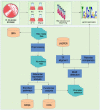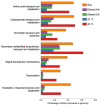Mining novel cis-regulatory elements from the emergent host Rhodosporidium toruloides using transcriptomic data
- PMID: 36687612
- PMCID: PMC9853887
- DOI: 10.3389/fmicb.2022.1069443
Mining novel cis-regulatory elements from the emergent host Rhodosporidium toruloides using transcriptomic data
Abstract
The demand for robust microbial cell factories that produce valuable biomaterials while resisting stresses imposed by current bioprocesses is rapidly growing. Rhodosporidium toruloides is an emerging host that presents desirable features for bioproduction, since it can grow in a wide range of substrates and tolerate a variety of toxic compounds. To explore R. toruloides suitability for application as a cell factory in biorefineries, we sought to understand the transcriptional responses of this yeast when growing under experimental settings that simulated those used in biofuels-related industries. Thus, we performed RNA sequencing of the oleaginous, carotenogenic yeast in different contexts. The first ones were stress-related: two conditions of high temperature (37 and 42°C) and two ethanol concentrations (2 and 4%), while the other used the inexpensive and abundant sugarcane juice as substrate. Differential expression and functional analysis were implemented using transcriptomic data to select differentially expressed genes and enriched pathways from each set-up. A reproducible bioinformatics workflow was developed for mining new regulatory elements. We then predicted, for the first time in this yeast, binding motifs for several transcription factors, including HAC1, ARG80, RPN4, ADR1, and DAL81. Most putative transcription factors uncovered here were involved in stress responses and found in the yeast genome. Our method for motif discovery provides a new realm of possibilities in studying gene regulatory networks, not only for the emerging host R. toruloides, but for other organisms of biotechnological importance.
Keywords: RNA sequencing; biorefineries; cell factory; industrial stress; motifs; sugarcane juice; transcription factor.
Copyright © 2023 Nora, Cassiano, Santana, Guazzaroni, Silva-Rocha and da Silva.
Conflict of interest statement
The authors declare that the research was conducted in the absence of any commercial or financial relationships that could be construed as a potential conflict of interest.
Figures







Similar articles
-
Genomewide and Enzymatic Analysis Reveals Efficient d-Galacturonic Acid Metabolism in the Basidiomycete Yeast Rhodosporidium toruloides.mSystems. 2019 Dec 17;4(6):e00389-19. doi: 10.1128/mSystems.00389-19. mSystems. 2019. PMID: 31848309 Free PMC article.
-
Integrating transcriptomic and metabolomic analysis of the oleaginous yeast Rhodosporidium toruloides IFO0880 during growth under different carbon sources.Appl Microbiol Biotechnol. 2021 Oct;105(19):7411-7425. doi: 10.1007/s00253-021-11549-8. Epub 2021 Sep 7. Appl Microbiol Biotechnol. 2021. PMID: 34491401
-
Multiplexed CRISPR-Cas9-Based Genome Editing of Rhodosporidium toruloides.mSphere. 2019 Mar 20;4(2):e00099-19. doi: 10.1128/mSphere.00099-19. mSphere. 2019. PMID: 30894433 Free PMC article.
-
Rhodotorula toruloides: an ideal microbial cell factory to produce oleochemicals, carotenoids, and other products.World J Microbiol Biotechnol. 2021 Dec 7;38(1):13. doi: 10.1007/s11274-021-03201-4. World J Microbiol Biotechnol. 2021. PMID: 34873661 Review.
-
The Engineering Potential of Rhodosporidium toruloides as a Workhorse for Biotechnological Applications.Trends Biotechnol. 2018 Mar;36(3):304-317. doi: 10.1016/j.tibtech.2017.10.013. Epub 2017 Nov 10. Trends Biotechnol. 2018. PMID: 29132754 Review.
Cited by
-
Non-canonical D-xylose and L-arabinose metabolism via D-arabitol in the oleaginous yeast Rhodosporidium toruloides.Microb Cell Fact. 2023 Aug 3;22(1):145. doi: 10.1186/s12934-023-02126-x. Microb Cell Fact. 2023. PMID: 37537595 Free PMC article.
-
Current landscape and future directions of synthetic biology in South America.Front Bioeng Biotechnol. 2023 Feb 10;11:1069628. doi: 10.3389/fbioe.2023.1069628. eCollection 2023. Front Bioeng Biotechnol. 2023. PMID: 36845183 Free PMC article. Review.
References
-
- Abdel-Banat B. M. A., Hoshida H., Ano A., Nonklang S., Akada R. (2010). High-temperature fermentation: how can processes for ethanol production at high temperatures become superior to the traditional process using mesophilic yeast? Appl. Microbiol. Biotechnol. 85, 861–867. doi: 10.1007/s00253-009-2248-5, PMID: - DOI - PubMed
-
- Andrews S. (2018). FastQC: a quality control tool for high throughput sequence data, FastQC: a quality control tool for high throughput sequence data. Available at: http://www.bioinformatics.babraham.ac.uk/projects/fastqc/ (Accessed October 10, 2022).
-
- Antonieto A. C. C., Nogueira K. M. V., de Paula R. G., Nora L. C., Cassiano M. H. A., Guazzaroni M. E., et al. . (2019). A novel Cys2His2 zinc finger homolog of AZF1 modulates Holocellulase expression in Trichoderma reesei. mSystems 4, 1–14. doi: 10.1128/mSystems.00161-19, PMID: - DOI - PMC - PubMed
-
- Bastian M., Heymann S., Jacomy M. (2009). ‘Gephi: an open source software for exploring and manipulating networks’. In Proceedings of the Third International ICWSM Conference, pp. 361–362.
LinkOut - more resources
Full Text Sources

